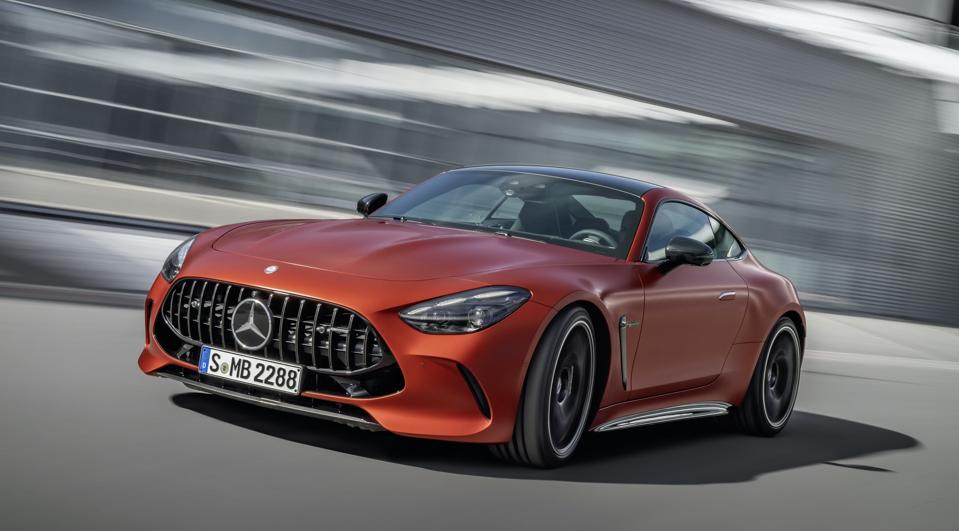“E” stands for electric, and Mercedes-AMG is cascading Formula One hybrid powertrain technology into a premier gran turismo, the gas-electric hybrid GT 63 S E that debuts today during the Formula One weekend in Shanghai. This gas-electric hybrid supercar has one of the best and most complex elevator stories of 2024. Time to get fully churched up to explain it all. Look to the lengthy photo captions for greater detail.
Centerpiece is the 4-wheel drive powertrain. Mounted up front is a highly evolved variant of AMG’s hand-assembled biturbo V8, spooling up 627 lb. ft. of torque between 2500-4500 rpm. Thanks to the wonders of turbo boost, 603 horsepower is fully available from 5750 to 6500 rpm, so the power is not peaky, but readily accessible—it’s there when you want it. Power from the combustion engine flows through a 9-speed gearbox. Even without the electric motor, this would prove a highly satisfying powertrain. I sampled a variation of this engine in the AMG SL 63—it’s gorgeous, as good as a V8 gets.
Ensuring the first two or three strides out of the running blocks are swift, and to boost available power throughout much of the rev range, AMG has mounted an electric motor at the rear with its own 2-speed gearbox. As speeds climb, the motor’s gearbox will kick it up a notch, to ensure that electric torque remains a factor at higher speeds and not just at launch.
The lithium-ion energy storage system (let’s call it a battery pack) is 400-Volt and liquid-cooled, ensuring the batteries are always at optimum temperature and capable of delivering maximum juice to the electric motor. Battery chemistry is formulated for performance, for extremely rapid discharge and recharge, as needed when circulating a racetrack or attacking a favorite mountain 2-lane with lots of corners. It can be plugged in to recharge with a 3.7 kW on-board AC charger.
That electric motor adds 94 electric-equivalent horsepower at all times, and when given the stick, up to 201 horsepower. But the real measurable is of course the 236 lb. ft. of electric torque, which is instantly available from zero revs. If the rear tires are overwhelmed with combined torque of V8 and electric motor, excess torque from the electric motor can in fact reach the front wheels. This is a 4MATIC system, after all.
A paragraph for the tech nerds who just need to know. Coolant used is electrically non-conductive and flows around all 560 cells. Compared to water, the coolant has a heat capacity that is two to three times higher and stores more thermal energy. For direct cooling of each cell, AMG developed new 0.04-inch super-thin cooling shafts. In short, this lithium-ion is totally chill, and totally AMG.
The end result is a 2+2 GT car with not only 805 combined horsepower, but in extremis with the battery and electric motor giving their absolute all under heavy acceleration in the Sport+ or Race calibration setting, 1047 lb. ft. of torque, a figure so robust it almost defies comprehension and belief. In those most aggressive of the eight calibration settings (Sport+ and Race), AMG GT 63 S E will hit 60 mph in 2.7 seconds. Few are the supercars and hypercars that can hit 60 mph in less than 3 seconds. This AMG GT lives in the most rarefied region of high-performance without the silhouette and practical limitations that come with so many mid-engine hypercars. Amazing what a dollop of instant-on electric torque can do.
AMG GT S E has a rated top speed of 199 mph, so active aerodynamics are mandatory, not a marketing affectation. At speeds above 50 mph, a carbon-fiber panel located under the nose of the car lowers by 1.6 inches. The resulting venturi effect in essence sucks the car down, ensuring the front wheels are firmly planted at ultra-high speeds.
Tucked smoothly into the trailing edge of the cargo hatch is the sort of active aero spoiler we’ve seen for some decades, and it helps keep the rear wheels pressed down hard. Depending on the calibration program selected, the spoiler can assume one of five positions above 50 mph to either optimize driving stability or reduce drag. Imagine the work of the software geeks scripting all these layers and functions between gasoline and electric power, active aero, and of course, active suspension.
Which leads us to AMG Active Ride Control, a multi-layered and multi-functional form of active suspension. Active hydraulic elements replace conventional mechanical torsion beam anti-roll bars and compensate for rolling movements in fractions of a second. In other words, when cornering the car will roll very, very little.
The adaptive dampers (known to Americans as shock absorbers) have two hydraulic connections: one on the compression side of the damper (the wheel is jouncing up after hitting a bump) and the other on the rebound side (the damper pushing the wheel smoothly and firmly back into the pavement). One assumes the suspension engineers and chassis tuners had more than a few after-work debate sessions at a favorite tavern in sunny Affalterbach, arguing about script, valving, hydraulic pump pressures, rear-wheel steering, and the like. All of it to deliver a car that glides with supreme confidence if you’re touring with a favorite companion or putting the hammer down flying solo on a mountain road.
So, you’re dropping the cash on one of the most advanced and sexy gran turismos ever offered, and maybe you love that line from Highlander: There can be only one. AMG’s MANUFAKTUR atelier is happy to oblige by painting and trimming your AMG GT 63 S E as a one-of-one, different from all others, a fine personal statement. AMG’s MANUFAKTUR atelier can paint and trim the car to suit any desires.

